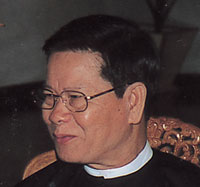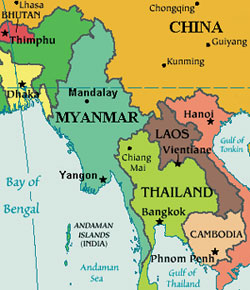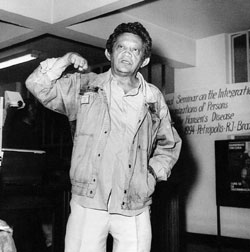| SPEECH |
|
| Achieving Leprosy Elimination |
| Speech by H. E. General Khin Nyunt, Secretary-1 of the State Peace and Development Council,
Union of Myanmar at the 3rd Meeting of the Global Alliance for the Elimination of Leprosy (GAEL)
Yangon, Myanmar February 6th to 8th, 2003 |
Leprosy is not only a public health problem; the side
effects of the disease result in deformity and disability,
and it also carries social stigma and economic costs to the
individual and the community. Therefore, the World
Health Organization has set a goal of eliminating leprosy
in the world by 2005. Moreover, the WHO and its
partners launched the Global Alliance for the Elimination
of Leprosy in 1999 to give further impetus to the fight
against leprosy. At this juncture, allow me to congratulate
the Global Alliance for the excellent work implemented
since its inception.
The government of Myanmar is fully committed to
ensure the highest possible standard of health as one of
the fundamental rights of every citizen. In keeping with
this political commitment, it has made noteworthy
efforts in improving the health of the people (especially
for women and children) and for
ensuring equitable access to health
care in the rural and border areas.
Our National Health Policy is
based on the Health for All goals
and its prime objective is to
strengthen Primary Health Care in our community. |

H.E. General Khin Nyunt
|
Like other developing nations, Myanmar has to face
a number of communicable and non-communicable
diseases like tuberculosis, malaria and leprosy.
Consequently, Myanmar undertook a number of disease
control programmes. Myanmar health workers, with the
enthusiastic support of the government and the people,
succeeded in controlling many devastating diseases.
I would like to put on record the importance of
multi-sectoral development, a mass literacy campaign, ever-improving transport and
communication systems, and
improving the environment (such
as ecology development in central
Myanmar and environmental
sanitation and clean water supply
systems) that have contributed to
the success of our disease control
efforts. The Leprosy Control
Programme in Myanmar is one of
those disease control programmes
that have been successful in
reducing the burden of disease in
our country. |

|
Myanmar was regarded as one
of the countries where leprosy
prevalence was very high. Soon
after independence, leprosy control was included as one
of the National Health Programmes. The total number
of leprosy cases was estimated in 1954-55 at around
200,000 cases in the country. However, in 1973, it was
estimated to be around 700,000 cases. Though this
Myanmar programme was regarded as one of the best
organized and technically sound, the limitation of
Dapsone therapy in the treatment of leprosy made
further progress difficult and reducing the burden of
disease problematical.
The introduction of Multi-Drug Therapy (MDT),
as recommended by WHO in 1986, paved the way for
the Elimination of Leprosy. At the same time, integrated
MDT service was expanded to more areas in the country,
achieving 100 per cent coverage in 1995 with the support
of WHO and our partners. Under the guidance of the
National Health Committee and Ministry of Health,
and with technical and financial support from WHO
and our international partners, elimination activities are
being carried out at grass-roots level in collaboration
with various local authorities and organizations. As a result of all these efforts, the
Leprosy Prevalence Rate now has
been reduced dramatically from
39.9 in 1988 to 1.04 per 10,000
inhabitants in December 2002.
At the end of January 2003, we
have reached our Leprosy
Elimination Goal. In other
words, the leprosy prevalence will
certainly decline to less than 1
per 10,000 inhabitants in
Myanmar.
Co-operation with our
partners is the cornerstone of our
leprosy elimination programme
in Myanmar. Collaboration and
mutual support among partners
in developing a comprehensive and consistent leprosy
elimination programme have proved to be the
cornerstone of our success. This relates not only to the
financial aspects of the programme but also to the
technical and operational side. Let me take this
opportunity to thank all our partners, especially WHO
and the international partners for their keen interest and
co-operation. We will continue our efforts, especially in
sustaining elimination and in establishing an appropriate
network for the care of disabled individuals in order to
minimize ill health and economic consequences.
The world has seen much progress in the struggle
against leprosy. But we must continue our efforts until
the goal set out by WHO is reached. I am confident that
the present meeting will contribute to identifying the
ways to overcome the remaining challenges, through
concerted and co-ordinated efforts. I would like to
express our sincere thanks to the organizers for their
excellent arrangements. In conclusion, may I wish you all
every success in your deliberations. |
| from Voices of Humanity |
To many of us, worse than the very disease is the
prejudice that comes along with it.
Many of us stopped being called Francisco, Joe, Maria,
and we started being called leprosy patients, 'lepers,' and
recently Hansenites.
I believe that our greatest challenge is to make sure that
millions of people who have lost their identities will go
back to being called by their own names.
Francisco A.V. Nunes, Brazil
IDEA's First President for Advocacy |

Photo by Pamela Parlapiano |
|